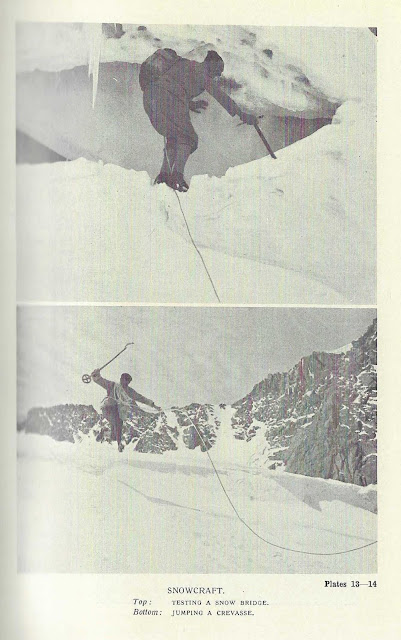Drink.—In mountaineering the question of drink is even more important than that of food, for it is quite likely that hunger will not shew itself before a considerable period of training has elapsed, whereas thirst will come quickly enough and requires no wooing.
The habit of drinking at every stream is to be discouraged, for it usually stimulates the craving that it is intended to allay, and it is a good rule in drinking to rely principally on what can be carried in the rucksack.
The habit of drinking at every stream is to be discouraged, for it usually stimulates the craving that it is intended to allay, and it is a good rule in drinking to rely principally on what can be carried in the rucksack.
Those who are subject to chills in throat or stomach should be cautious about drinking very cold water when they are exhausted or overheated. In these circumstances a dash of spirits added to the water may spoil the flavour but make a safer drink. Some find it agreeable to reverse the ordinary procedure of drinking and prefer red wine for the chilly dawn breakfast on the mountainside, while reserving tea for drinking during the heat of the day. The addition of wine, lemon, and sugar to tea makes a very refreshing mixture. It is worth while to know that very good tea can be made by soaking the leaves for about six hours in cold water and then straining.
A more curious drink, recommended by a climber who was consuming it when exhausted on his return to Randa from traversing the Dom and the Täschhorn, one hot day in August, was served in a jug and a bottle and consisted of hot milk and cold water, which the drinker mixed together. He claimed that this peculiar concoction was warm enough to avert chills, cool enough to be drunk with the utmost rapidity, and sufficiently unappetising to diminish an otherwise insatiable thirst.
A more curious drink, recommended by a climber who was consuming it when exhausted on his return to Randa from traversing the Dom and the Täschhorn, one hot day in August, was served in a jug and a bottle and consisted of hot milk and cold water, which the drinker mixed together. He claimed that this peculiar concoction was warm enough to avert chills, cool enough to be drunk with the utmost rapidity, and sufficiently unappetising to diminish an otherwise insatiable thirst.
References
Chapter Three “Equipment” by C F Meade in The Lonsdale Library of Sports, Games and Pastimes, Volume XVIII, Mountaineering, London: Seeley Service & Co, 1934.
Chapter Three “Equipment” by C F Meade in The Lonsdale Library of Sports, Games and Pastimes, Volume XVIII, Mountaineering, London: Seeley Service & Co, 1934.









